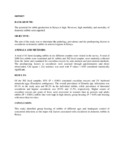| dc.description.abstract | BACKGROUND:
The potential for rabbit production in Kenya is high. However, high morbidity and mortality of domestic rabbits were reported.
OBJECTIVE:
The aim of the study was to determine the pathology, prevalence and the predisposing factors to coccidiosis in domestic rabbits in selected regions in Kenya.
ANIMALS AND METHODS:
A total of 61 farms keeping rabbits in six different counties were visited in the survey. A total of 2680 live rabbits were examined and 61 rabbits and 302 fecal samples were randomly collected from the farms and examined for coccidian oocysts by ante-mortem and post-mortem methods. The predisposing factors to coccidiosis were assessed through questionnaires and direct observation. Chi square (χ(2)) statistics was used with P values < 0.05 considered statistically significant.
RESULTS:
Of the 302 fecal samples, 85% (P < 0.001) contained coccidian oocysts and 2% harbored nematode eggs (Passalurus ambiguous). The overall prevalence of Eimeria spp. infestation was 85.1% in the study area and 90.2% in the individual rabbits, while prevalence of intestinal coccidiosis and hepatic coccidiosis was 29.5% and 11.5%, respectively. Higher counts of coccidian oocysts per gram of feces were recovered in weaners than in growers and adults rabbits (P < 0.001), rabbits that were kept in high density group housing (P < 0.05) and housing with more than two tiers.
CONCLUSION:
This study identified group housing of rabbits of different ages and inadequate control of concurrent infections as the major risk factors associated with coccidiosis in domestic rabbits in Kenya. | en_US |

